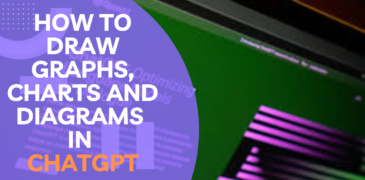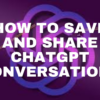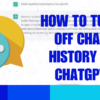In the world of artificial intelligence, ChatGPT has emerged as a versatile language model capable of transforming mere text into meaningful conversations. But did you know that ChatGPT has expanded its capabilities beyond just language processing? Yes, you heard it right! Now, with the integration of graph plotting libraries and diagram generation tools, ChatGPT can draw captivating visualizations right within your conversations. In this article, we’ll take you on a comprehensive journey, explaining how to unleash the potential of ChatGPT to create stunning graphs, charts, and diagrams. Buckle up as we dive into the world of data visualization and elevate your virtual interactions to a whole new level.
A Glimpse into ChatGPT’s Visualization Features
- ChatGPT, powered by the robust GPT-3.5 architecture, has opened up exciting new possibilities by combining language understanding with graphical representation. The integration of graph plotting libraries allows ChatGPT to transform raw data into visually appealing graphs and charts, while diagram generation tools enable the creation of intricate diagrams to illustrate processes and relationships. This fusion of textual and visual capabilities empowers users to communicate complex ideas with ease and clarity.
Getting Started: Accessing Visualization Capabilities
- To begin your journey into the world of visualizations with ChatGPT, you need access to a GPT-3.5 enabled platform that supports the integration of graph plotting libraries and diagram generation tools. Various online interfaces and APIs provide this functionality, enabling you to interact with ChatGPT and draw insightful visual representations.
Initiating Visualization Requests
- To draw a graph, chart, or diagram using ChatGPT, start a conversation by specifying your intention to create a visualization. Clearly articulate the type of visualization you need and provide relevant context. Depending on the complexity of your request, you may need to input raw data or answer a series of questions to help ChatGPT generate accurate visuals.
Choosing the Right Visualization Type
Selecting the appropriate visualization type is crucial for effectively conveying your data’s insights. Fortunately, ChatGPT is well-equipped to assist in this decision-making process. Depending on the nature of your information, you may opt for:
- Bar Charts: Ideal for comparing categories or showing frequency distributions.
- Line Graphs: Illustrate trends and changes over time.
- Pie Charts: Display parts of a whole, perfect for proportions.
- Scatter Plots: Demonstrate correlations between variables.
- Venn Diagrams: Showcase overlapping relationships between sets.
- Flowcharts: Visualize processes and decision-making pathways.
Providing Data and Context
- For ChatGPT to generate an accurate visualization, ensure you provide relevant data points and context. The quality of the visualization heavily relies on the accuracy and completeness of the information provided. This may involve formatting data in a specific way or clarifying any ambiguous points to refine the final output.
Customizing Your Visualizations
- To give your visualizations a personal touch and make them visually appealing, ChatGPT allows for customization. You can specify colors, labels, titles, and other visual elements to match your style and preference, making the visual representation uniquely yours.
Reviewing and Refining
- After ChatGPT generates the initial visualization, review it carefully for accuracy and clarity. If necessary, engage in iterative conversations with ChatGPT to refine the visualization further. This process ensures that the final output aligns perfectly with your requirements.
Exploring Interactive Features
- Beyond static visualizations, ChatGPT enables interactive exploration of your data. Engage in conversations to ask questions, seek additional insights, and experiment with “what-if” scenarios to gain deeper understanding and analyze various data facets effectively.
Integrating Visualizations in Conversations
- The inclusion of visualizations in your conversations adds a layer of comprehension and engagement. Whether you’re using ChatGPT for educational purposes, business presentations, or data analysis, these dynamic visual elements facilitate clear communication and foster a deeper understanding among your audience.
Unleashing Creativity: Beyond Standard Visualizations
- While ChatGPT offers various standard visualization types, it’s worth exploring and experimenting with unique graphical representations that suit your specific needs. Think outside the box and discover new ways to make your data come alive in ways you hadn’t imagined before.
Also read:
How to Effectively use ChatGPT for Content Creation?
Jasper vs ChatGPT: Which one is a better AI based content writing tool?
5 Ways Artificial Intelligence Boosts Employee Productivity
How to use OpenAI for Image Creation? (GUIDE)
FAQs
Can I really draw graphs and charts within ChatGPT conversations?
Absolutely! ChatGPT’s integration with graph plotting libraries and diagram generation tools enables it to draw various types of visualizations. From simple bar charts to complex flowcharts, ChatGPT can bring your data to life right within the conversation.
What kind of data does ChatGPT require to create visualizations?
The data required depends on the type of visualization you want to create. For basic visualizations like bar charts and line graphs, you can provide the relevant data points directly. However, for more intricate diagrams or specialized charts, ChatGPT may prompt you for additional context or specific data formats.
Can I customize the appearance of the visualizations in ChatGPT?
Yes, you can! ChatGPT allows you to personalize the visual elements, such as colors, labels, titles, and more, to match your preferences and style. Customization enhances the visual appeal and helps tailor the visualization to your specific needs.
How accurate are the visualizations generated by ChatGPT?
The accuracy of the visualizations depends on the accuracy and completeness of the data you provide. It’s essential to ensure the data is reliable and correctly formatted. Additionally, iterative conversations with ChatGPT can help refine the visualization further for improved accuracy.
What types of visualization can I create with ChatGPT?
ChatGPT supports a wide range of visualizations, including but not limited to bar charts, line graphs, pie charts, scatter plots, Venn diagrams, and flowcharts. You can choose the type that best suits the data and insights you wish to convey.
Can I interact with the visualizations created in ChatGPT?
Yes! ChatGPT’s interactive capabilities extend beyond the initial visualizations. You can ask questions, seek additional insights, and experiment with different scenarios related to the data. This interactive exploration enhances your understanding and facilitates data analysis.
Is it possible to draw unique and unconventional visualizations with ChatGPT?
Absolutely! While ChatGPT offers standard visualization types, you can unleash your creativity and experiment with unconventional graphical representations. Feel free to explore new ways of presenting data to suit your specific needs and audience.
Can ChatGPT be used for business presentations and educational purposes?
Yes, indeed! ChatGPT’s ability to create dynamic and informative visualizations makes it a valuable tool for business presentations, educational materials, and data analysis. The incorporation of visuals enhances engagement and fosters better communication with your audience.
Are there any limitations to drawing visualizations in ChatGPT?
While ChatGPT’s visualization capabilities are impressive, it’s essential to remember that it relies on the data and context provided. Ensuring the accuracy and relevance of the input data is crucial for generating meaningful visualizations. Additionally, complex or large datasets may pose challenges, and iterative refining might be necessary for intricate visualizations.
Can I use the visualizations generated by ChatGPT in other applications?
Yes, you can! ChatGPT allows you to export the visualizations in various formats, such as images or data files. You can then use these visualizations in other applications, reports, or presentations as needed.
Conclusion
In conclusion, ChatGPT has evolved into an all-encompassing AI tool that not only processes language but also wields the power of data visualization. Drawing graphs, charts, and diagrams with ChatGPT adds an exciting dimension to virtual interactions, making them more informative and engaging. Through its integration with graph plotting libraries and diagram generation tools, ChatGPT allows users to transform raw data into eye-catching visual representations with ease.
As you embark on your journey of data exploration with ChatGPT, remember to provide accurate data and context, choose the right visualization type, and embrace the interactive features to enhance your understanding further. Unleash your creativity, customize your visualizations, and weave compelling narratives that captivate your audience.
So, why settle for static text when you can create dynamic visualizations that leave a lasting impact? Embrace ChatGPT’s visualization capabilities and revolutionize the way you communicate data and ideas. With ChatGPT as your creative ally, your virtual conversations will become richer, more vibrant, and ultimately, more meaningful. Happy graphing and charting!







